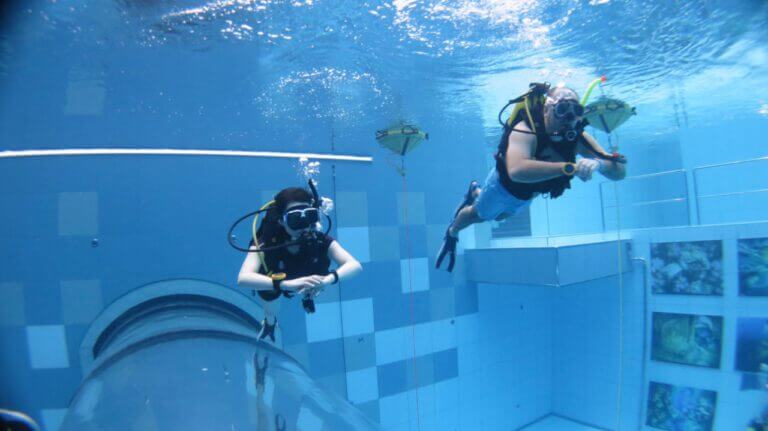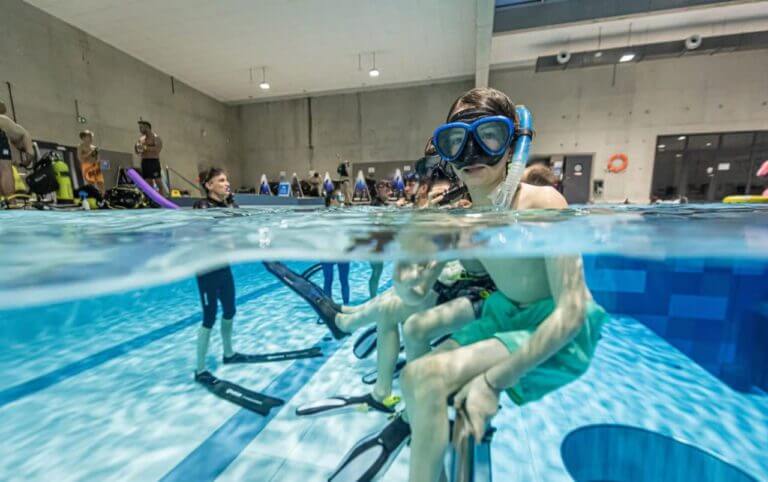What is diving? In the simplest terms, scuba diving is being underwater on what is known as a “dive”. stopped breathing(freediving) or staying underwater with appropriate equipment(scuba diving). Diving can be done for a variety of reasons and purposes, reaching for techniques appropriate to the situation and the diver’s skills. What is scuba diving and what are its types? How to start diving, who can dive and what are the contraindications to diving? What do beginners and advanced divers get from diving schools and courses? Find the answers to these and many other questions below!

What is scuba diving and what is its history?
Diving has accompanied man since the dawn of time. Thousands of years ago, people dived primarily for food, but also in search of “treasure” and for military purposes. At the time, people dived primarily on a held breath, but also with cane stalks in their mouths – the other end of the cane protruded above the surface of the water and allowed them to take a breath without surfacing (the modern equivalent of this method is snorkeling).
History of diving – where did it start?
The oldest engravings and descriptions of diving date back to the 1st century BC. These include. a bas-relief from 885 B.C. depicts an armed man breathing underwater using equipment resembling modern-day diving cylinders, as well as Aristotle’s record, dated 332 B.C., of a diving bell said to have been used by Alexander the Great during the siege of Tyre.
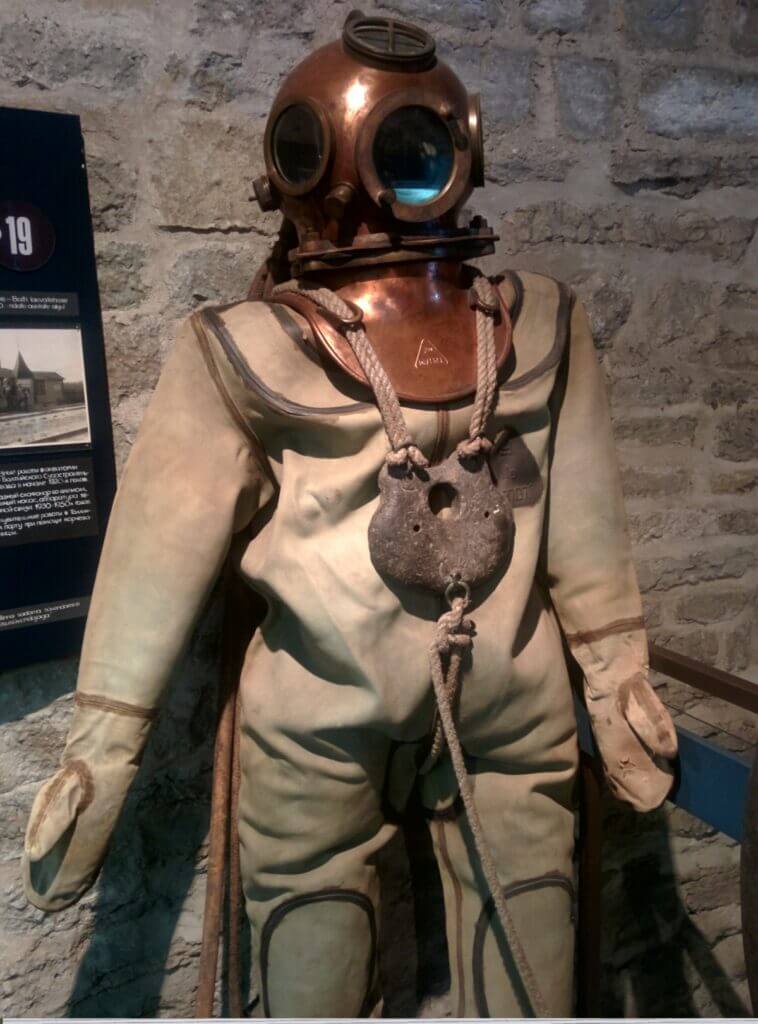
Discoveries and inventions – the road to safe diving
The goal of the scientists and inventors who were involved in diving became, in the centuries that followed, to develop solutions to increase the time spent underwater. Leonardo da Vinci is considered the author of the first design of a self-contained underwater breathing system and the first diving suit. A breakthrough invention in the field of diving was the first diving system that allowed free movement underwater, designed in 1797 by Karl Heinrich Klingert.
In the 18th and 19th centuries, many innovations were tested simultaneously. In 1823, the Deane brothers patented a firefighter’s helmet to protect firefighters from the effects of smoke inhalation. Soon after, the firefighter’s helmet, at the request of the inventors, was adapted for diving by August Siebie. It is he, incidentally, who is considered the “father of diving.” It’s all due to the complete, enclosed classical diver’s outfit patented in 1837 – made of gas-tight fabric, with heavy boots and weights (allowing for adjustable buoyancy) and air supply via a rotary pump. The outfit was the first to make it possible to really stay safely underwater for an extended period of time.
Popularization of diving
A surge of interest in diving was noted in the first and then the second half of the 20th century. The popularization of underwater adventures has been most significantly influenced by increasing the safety of divers through the use of modern technological solutions, while gradually reducing the price of suits and the cost of operating breathing apparatuses. Today, millions of people around the world are engaged in diving.

Diving methods – division by technique and equipment selection
Snorkeling, freediving and scuba diving can be accomplished by one of three basic methods: snorkeling, freediving and scuba diving. What are the characteristics of these methods?
Snorkeling – amateur diving for everyone
Snorkeling is the simplest form of diving, involving floating or swimming just below the surface of the water, with simple equipment that allows you to admire the underwater world without having to surface for air.
The basic equipment for snorkeling is called. ABC equipment:
- Mask – protect the eyes from contact with water and allow clear vision,
- snorkel (from English – hence the name of the diving method) – allows you to breathe freely without raising your head above the water level / without surfacing,
- fins, which significantly increase a diver’s mobility and speed up swimming.

Freediving – diving on held breath
Freediving, translated as free diving, or diving without an aqualung (but not without any equipment at all!) – on held breath, is one of the two basic methods of diving, in which one actually goes underwater to a chosen depth (in snorkeling, the diver merely floats on the water or is just below the surface – he does not go deep). The length of a freediver’s immersion depends on how long they can safely hold their breath underwater. As part of the preparation for the first freediving, it is necessary to conduct breathing exercises and learn the principles of safe immersion and emergence from the water.
Freedivers do not use an aqualung that allows them to stay/breathe underwater, but they can:
- masks and goggles – they protect the eyes and increase the comfort of admiring the underwater world,
- Swimming foams or skins – they protect the diver’s body from cooling too quickly,
- fins – to increase the mobility of the diver,
- ballast – for effective management of submergence depth.

Scuba diving – scuba diving with aqualung
Scuba diving is equipment diving. A diver practicing scuba diving is equipped with an aqualung, which is equipment that allows him to swim and breathe freely underwater. This is the only diving method that allows you to stay underwater and explore the underwater world continuously for an extended period of time.
The basic equipment of a scubadiver is:
- ABC equipment – mask, snorkel and fins (snorkel used in snorkeling – here it comes in handy, for example, in situations when you want to swim up to the place of immersion without using air from the cylinder),
- Breathing machine and oxygen cylinder,
- Foam or dry suit.
Optionally, the scubadiver’s equipment can also include:
- Dive computer – a small device in the form of an elaborate wristwatch, high-end dive computer indicates, among other things. the depth of the dive and the time spent underwater, warns against ascending too quickly, and informs about the limit of no-decompression time at a given depth (taking into account previous dives),
- A buoyancy vest (as an alternative to the traditional board and buoyancy bag),
- Diving flashlight – to bring out disappearing colors in murky waters or at depths of less than 10 m, essential for night dives.

Types of diving – a division by the purpose of diving
You can dive for different reasons and purposes, and the division into recreational diving (rec diving) and technical/sports diving (tec diving) is definitely not exhaustive.
Here are the most popular types of diving and the techniques used in them:
Amateur recreational diving – snorkeling
This is the type of diving that is practiced by the largest number of people around the world. Snorkeling can be practiced with almost no restrictions (age and health) and without any major preparation – just fitting a mask and mastering the skills of breathing with a tube / snorkel. Snorkeling is hugely popular among tourists visiting the country, including. Egypt, Croatia, Greece or Italy.
The most beautiful snorkeling spots include:
- beaches around the Maltese islands of Gozo and Comino
- beaches off the town of Isola Rossa in Sardinia
- beaches around Paphos, Cyprus
- Croatian Riviera of Makarska
- The rocky coast around the Spanish island of Medes
- The azure coastlines around the Greek islands of Skiathos and Skopelos.
Recreational diving – freediving and scuba diving
Recreational diving can be practiced in many different ways, without or with equipment, by both beginners and advanced divers of varying degrees. Unlike amateur snorkeling – recreational diving practiced by freediving and scuba diving methods should always be preceded by training appropriate to the technique. Regardless of the method chosen and the type of equipment or aqualung (or lack thereof) – the purpose of recreational diving is to relax and unwind, a way to meditate (especially in the case of freediving) and to enjoy admiring the underwater world and overcoming one’s own barriers.
Freediving and scuba diving can be practiced both in natural bodies of water and in special pools – simulators of diving conditions. The contractual limit for recreational diving is 40 meters deep.
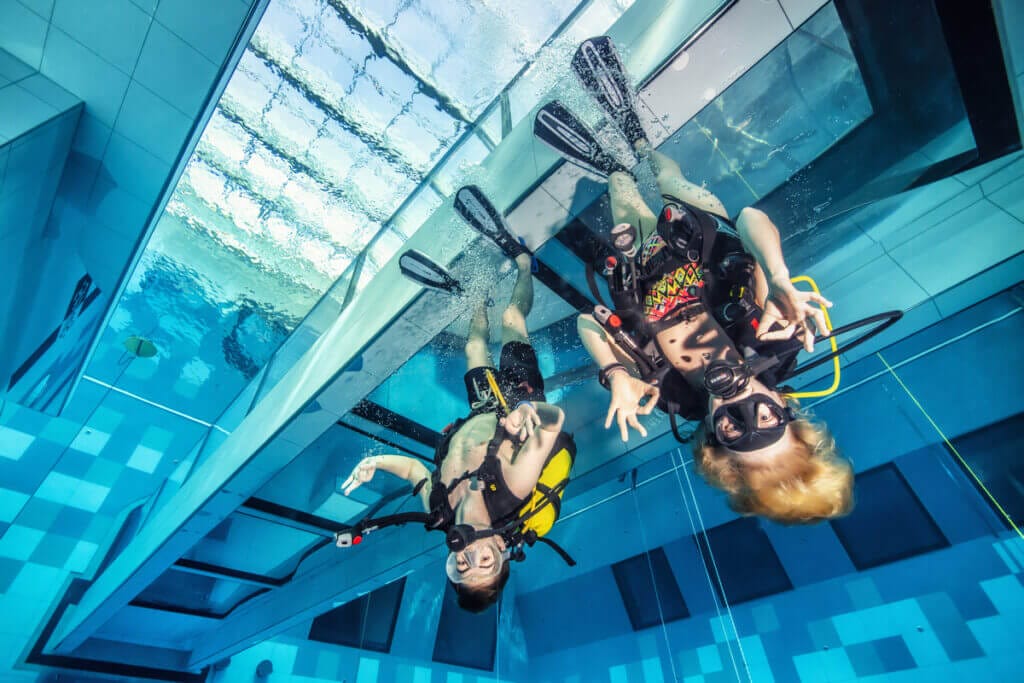
Amateur sport diving – freediving and scuba diving
Sport diving can be a form of recreation at the same time. What distinguishes sports diving from recreational diving is, among other things. frequency and regularity of dives (recreational diving is usually occasional). The goal of those treating diving as a sport is also different – diving in this case is supposed to be a kind of physical activity, during which certain activities are performed and all muscle parts are engaged. Divers also strive to improve their performance, to increase their mobility and efficiency, their diving speed or their speed of movement underwater.
Amateur sport diving can be practiced both in natural bodies of water and in special pools – simulators of diving conditions.
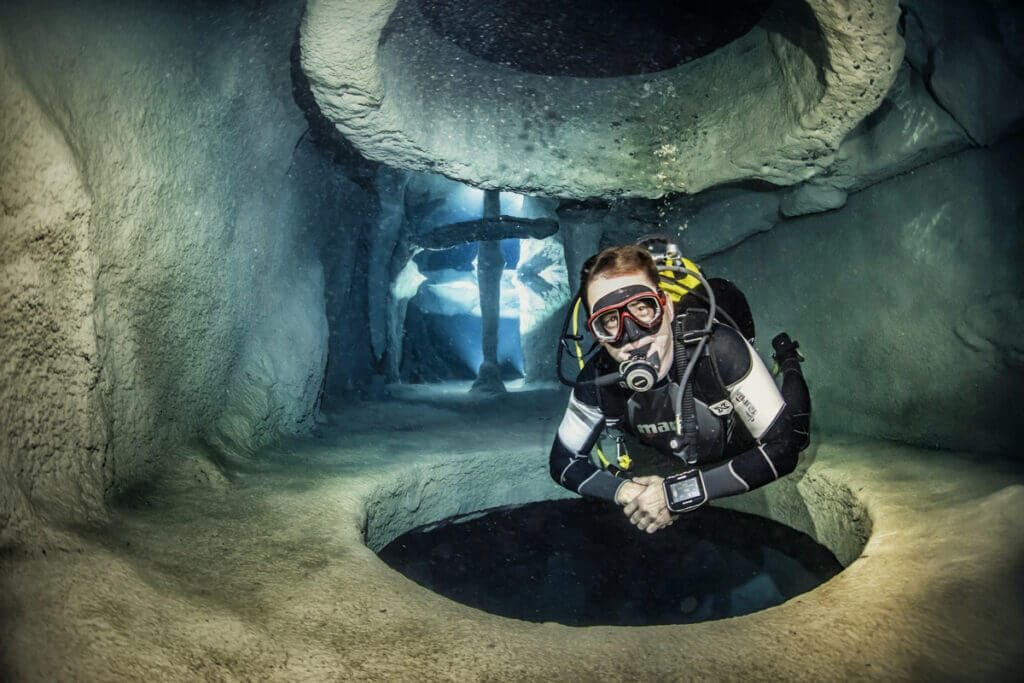
Technical diving – freediving and scuba diving
Technical diving (also referred to as professional or sport diving) is dedicated only to experienced divers with extensive knowledge and highly rated skills, as well as the right equipment – definitely more advanced than in recreational diving. This is a dive that requires divers to be in good physical condition and to be free of any contraindications to this activity (technical divers must undergo regular medical check-ups to confirm very good health).
Technical diving can be quite a strain and challenge to the body, as it definitely exceeds recreational limits – regarding the depth of immersion (divers technically exceed the 40m depth limit) and/or the length of time they stay underwater. Technical diving can be performed at different depths, with or without changing decompression gases, using multiple breathing mixtures during a single dive. Therefore, technical diving involves more risk than recreational diving.
The goal of technical diving is to improve one’s skills, improve one’s performance and acquire more degrees, among others. by exceeding standard time and depth limits, but always with safety rules. It is imperative to learn technical diving under the guidance of an experienced instructor, such as specialized courses provided by tec diving organizations TDI, IANTD or PADI/DSAT.
The most important rule of technical diving is to plan your dive precisely, and then dive according to that plan. The so-called. Run Time details the entire course of a dive: from submergence to ascent, specifying the points where the diver should be at any given time. Run Time planning should involve optimizing the dive in all respects.

Wreck diving – scuba diving
Wreck diving is diving that aims to explore sunken wrecks and other objects that are the result of human activity (as opposed to exploring underwater flora and fauna), such as sunken oil rigs or sunken cities. Penetration of submerged objects is carried out by equipment diving, or scuba diving.

Cave diving – scuba diving
Cave diving is diving that aims to explore underwater caves, passageways and adits. Cave diving can be carried out at various depths, but most often involves the inability to ascend vertically to the surface, so it requires proper training and skills (rather exceeding rec diving skills), very good physical fitness and mental toughness. Cave diving is done with equipment, that is, under the scuba diving method.

Commercial and professional diving
We speak of commercial and professional diving when it is directly related to work. Commercial diving is performed by the so-called. professional diver, i.e., a person who has the appropriate psycho-physical qualities and the necessary skills, as well as the qualifications / authorizations confirming them.
A professional diver must have a certificate of completion of a dedicated course, which includes. Class information: a Class III diploma authorizes professional diving at depths of up to 20m, a Class II diploma authorizes professional diving at depths of up to 50m, and a Class III diploma authorizes professional deep-sea diving and underwater work at depths of more than 50m. The health requirements for a professional diver are strictly defined by the Ministry of Health Regulation on Health Conditions for Underwater Work.
Professional divers include:
- diving instructors,
- people who dive for research and scientific purposes, conducting, for example, biological research and archaeological studies),
- rescue divers (Rescue Diver)
- police divers
- prospecting divers – extractors
- Engineering divers, working, for example, in the operation of hydraulic structures, maintenance of ships or welding of individual elements of platform and quay structures.

Diving equipment
Scuba diving equipment is a very broad category in which new products regularly appear. In the most general terms, diving equipment can be divided into ABC equipment (which is the only equipment of a person diving on held breath, using the freediving method) and other diving equipment / air equipment (which is more or less extensive and advanced equipment of the scuba diver) and additional accessories / auxiliary equipment.
ABC equipment: mask, fins, snorkel
ABC equipment is a mask, fins and snorkel, which make snorkeling possible, the only equipment for freedivers and the basic equipment for scubadivers (but not sufficient for diving by this method). ABC equipment is individual equipment, which means that every diver, even a beginner, should have his own set (at selected dive bases it is possible to rent ABC equipment).
Diving mask
An essential piece of equipment for a diver, enabling proper (sharp, clear) and comfortable vision underwater, thanks to the creation of air space in front of the eyes. A properly fitted mask protects the eyes and nose from contact with water and allows the mask to equalize pressure (through the nose). The diving mask includes the following components:
- Frame / body – the frame is made of plastic, different types / shapes of bodies are available, so you can optimally fit the mask to the shape and size of your face;
- sealing collar – the collars of modern masks are made of silicone (usually transparent, white / milky or black), the collar has a minimum of double sealing on the rim and covers the entire body, except for the section below the soft nose (so that it is possible to effectively drain the water during diving, the so-called “blowout” of the mask);
- Tempered glass (on the front of the mask, covering the eyes) – tempered glass guarantees maximum safety, making it virtually impossible to break the mask (however, if the glass were broken – it would shatter into small pieces with blurred edges), the most common diving masks have one or two panes, in more advanced models, allowing panoramic vision underwater – there may be more panes (for example, three or six);
- soft nose (covers the nose) – a part of the body covering the nose, made of soft and flexible plastic (such a design allows you to compress the nose and equalize the pressure in the mask and “blow” the mask);
- strap with adjustment system – the straps of modern diving masks are made of silicone (most often identical to the one used for the collar) and have a split in the middle part (to minimize pressure on the head and the risk of displacement of the strap / mask), the task of the strap is to pre-press the mask to the diver’s face.
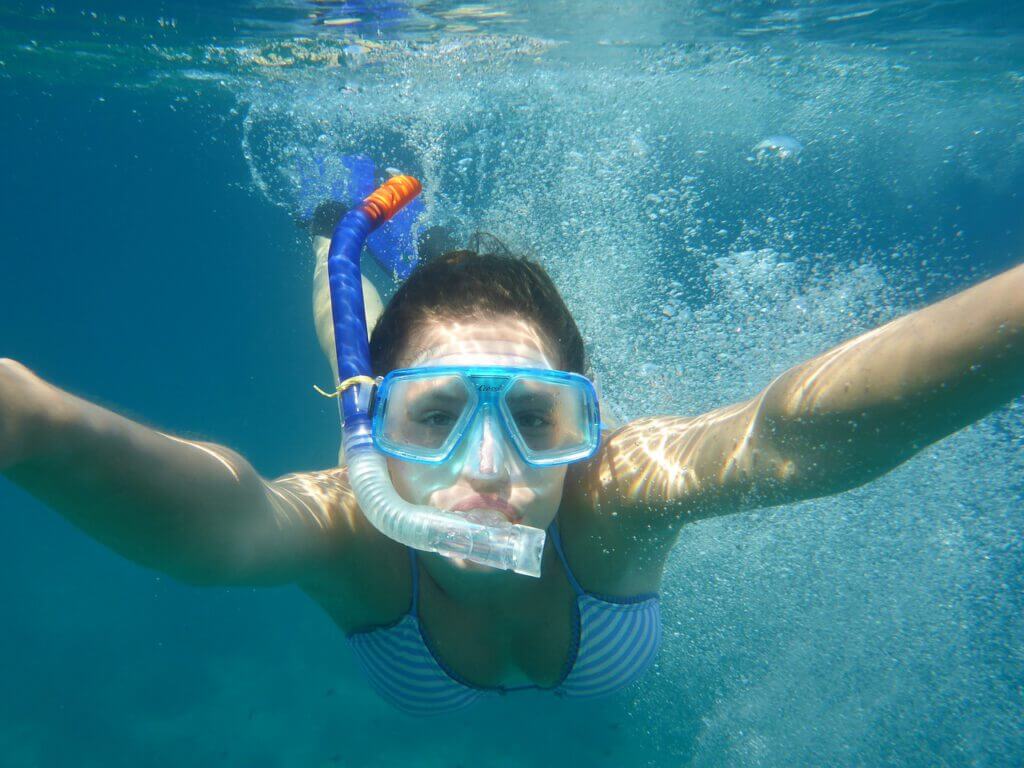
Snorkel
The snorkel allows you to breathe air without having to emerge from the water. This is the piece of equipment that makes snorkeling possible, and is rarely, very rarely or not at all useful in the rest of the diving techniques. The snorkel can be used, for example, when swimming to a fixed dive site or when returning from a dive, especially when there is a long distance to cover in difficult surface conditions (such as at sea, with high waves or strong current). The snorkel includes the following components:
- tube – modern tubes have an anatomical shape (fitting the shape / contour of the head, without sharp bends or narrowing that makes it difficult to take in and exhale air), the diameter of the tube should be about 2 cm, and the length of the tube about 30-35 cm;
- Mouthpiece – made of silicone, it should be of a size and shape that allows you to easily put it in your mouth and hold it comfortably with your teeth (in classic models: by two tabs, in modern mouthpieces the tabs are connected by an additional, properly shaped element);
- check valve (optional) – located below the mouthpiece and makes it easier to empty the pipe of water;
- labyrinth valve (optional) – located at the end of the tube and restricting water from pouring into the pipe;
- clasp – an external and mobile element, applied to the tube allows you to connect the snorkel to the strap of the mask in such a way that it can be comfortably inserted into the mouth.
Diving fins
The purpose of the fins is to increase the surface area of the feet and thus maximize our motor capabilities in the water. Flippers allow you to swim quickly and efficiently using only your legs. The construction of fins is relatively simple – each fin consists of: a fin foot (calliope or strap) and a fin feather (which accounts for the propulsive force of the fins, the feathers can vary in size / length and hardness and vary in shape and functionality).
Fins should not only fit the foot, but also be matched to the diver’s skills and condition. Strip fins are used for diving:
- Classic – consist of a feather and a foot, available in different degrees of softness / hardness,
- with a slit – consist of a pen with a slit, they are very soft and easy to use even by beginners,
- technical jet fins (short and hard strip fins, used primarily in technical diving, requiring excellent skills and strong legs).
Airborne equipment
Airborne equipment is equipment that allows you to stay underwater for extended periods of time. Air equipment consists of three components: a cylinder or set of cylinders, a breathing machine and a buoyancy system (KRW, BCD or wings).
Diving cylinder / diving cylinder set
Diving cylinders are cylindrical containers of a certain capacity (most commonly: 10l, 12l, 15l, 18l), used to collect/store air at an increased pressure of 150-300at (15-30MPa), which we will use underwater. Cylinders can be made of carbon steel (used primarily in cold and fresh water) or alloy steel and aluminum alloys (used primarily in warm and saltwater). Aluminum cylinders are larger and heavier than steel cylinders of the same capacity, but in the water they become lighter than steel cylinders – they have neutral buoyancy (positive or slightly negative). Steel cylinders have negative buoyancy, so they can reduce the load in a diver’s ballast system.
The steel diving cylinder consists of the following components:
- Cylinder – steel (with a convex bottom) or aluminum (with a flat bottom), available in a variety of capacities (ranging from 4l to 18l), and therefore in different sizes and weights;
- Net – performs the protective function of the cylinder, protecting it from mechanical damage; made of special threads, closely matched to the dimensions of a particular cylinder;
- valve – allows you to control the flow of gas from the cylinder;
- handle – allows you to carry the cylinder comfortably and safely;
- foot – a piece made of plastic / plastic, also called a pot, which is put on the lower, convex part of the cylinder and allows it to stand on the ground (the flat bottom of aluminum cylinders does not require additional feet).
An aluminum diving cylinder usually consists of only two components: the cylinder and the valve.
Two, connected to each other by a special design / handle diving cylinders are Twinset. Two-bottle sets are used primarily by technical divers, but also for cave or wreck diving.
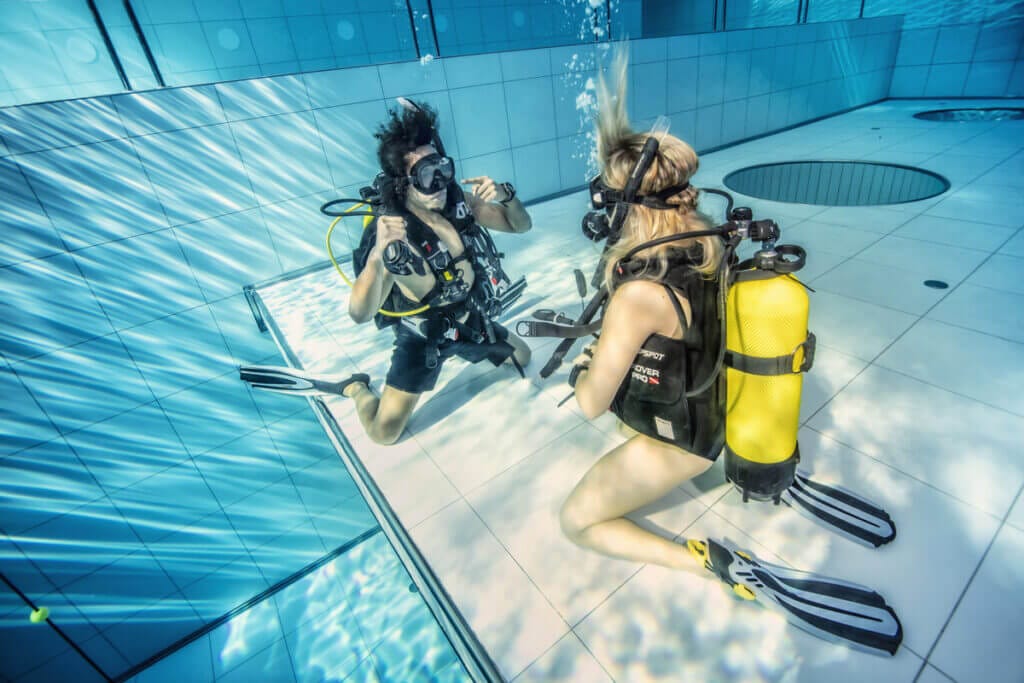
Breathing machine
This is one of the most important pieces of diving equipment, crucial to our safety. It is imperative for a diver to know how an automatic breathing apparatus works, to be able to connect it intuitively and correctly to the cylinder, and to operate it confidently in emergency situations as well. The chosen breathing machine should be properly stored and regularly serviced.
The automatic breathing machine consists of the following components:
- the first stage of the breathing apparatus (diaphragm or piston, with DIN or INT type connection) – screwed to the diving cylinder, reduces the high pressure from the cylinder to a positive pressure of about 10at;
- The second stage of the automatic breathing apparatus (may additionally have respiratory resistance adjustments) – is located directly at the mouth, reduces the positive pressure from about 10at to ambient pressure;
- Octopus, or alternative air source – currently absolutely required;
- Pressure gauge – a device that allows you to control the supply of air / gas in the cylinder (optionally, the pressure gauge can be part of the console, that is, a device that has more indicators, such as in addition: compass, depth gauge, dive computer);
- Inflator and inflator hose – allowing to fill and empty the system / buoyancy bag.
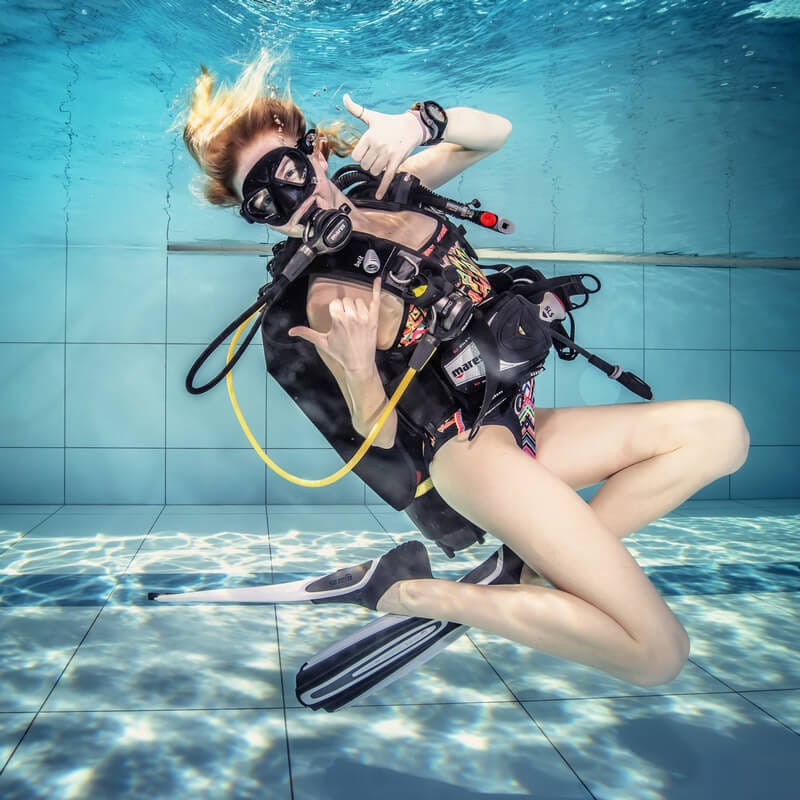
Displacement system
A diver’s buoyancy system is nothing more than a KRW rescue and compensation vest (BCD, or Buoyancy Control Device). The vest is a must-have piece of equipment for every diver, increasing his safety and making diving more comfortable.
KRW’s task is:
- Allowing the diver to change buoyancy (to negative, positive or neutral buoyancy, depending on the current need),
- Allowing the diver to quickly surface the water in emergency situations,
- Allowing the diver to stay safely on the surface of the water (preferably in the so-called safe position, i.e. face up).
KRW vests are available in a variety of designs, so that, every diver can choose a model that will be optimally suited to his or her size, needs and skills.
Types of KRW:
- Jacket-type KRW – the most popular and most commonly used type of vest, easy to use, Jacket can be: adjustable (with the ability to adjust the length of the arms to suit your figure and current needs, such as for diving in a foam or dry suit) or full (with full arms, without the ability to adjust – it is necessary to accurately size KRW);
- Wing-type KRW – a type of lifejacket attached to the back (filling the buoyancy bag does not squeeze the diver at the waist, as is the case with the classic Jacket-type KRW), which was originally used by technical divers, and is now entering widespread use in recreational diving.

Support equipment – additional diving equipment and accessories
This is a wide range of different types of equipment and accessories that are designed to make diving easier and improve the diver’s comfort and optimize his safety underwater.
Auxiliary equipment includes, but is not limited to:
- Ballasts (including belt ballasts and leg ballasts)
- dive consoles and dive computers
- Individual gauges to expand your individual measurement system, including: dive watches, thermometers, depth gauges, compasses, gauges / meters
- light accessories – flashlights, LED flashlights, HID flashlights, flashes and chemical light
- sounders
- diving slates – allowing you to record and read information/messages to your partner underwater
- knives, net knives and secateurs, as well as multifunctional utensils
- screws and ice augers
- underwater scooters – amateur and professional
- Dive bags and transport cases – to facilitate the safe transportation / carrying of diving equipment.

How to start diving?
Scuba diving is a very enjoyable form of physical activity that is relatively simple in its recreational form. Where and how to start diving? Those who want to start diving should begin by acquiring basic knowledge of diving physics and technique, as well as mastering the most important skills (including those related to breath-holding and breathing with a breathing apparatus, related to the operation of equipment and aqualung).
Learning to dive should always take place under the guidance of an experienced, active diving instructor, preferably in strictly controlled and maximally safe conditions – in special pools or modern diving simulators (Deepspot is the deepest such facility in the world).
In theory, only trained, certified divers can dive. In practice, however, thanks to modern schools and organizations, almost any person interested in diving (who meets the necessary conditions and has no contraindications) – can try their hand and see if diving is just for them.
First dive – a test dive
Deepspot provides Try Scuba and Try Freediving services. This is an option for people who have never dived before and want to try their hand at it without any commitment.
- Discover Freediving – is an opportunity to make your first dive on stopped breath, under the guidance of a qualified and experienced instructor,
- Discover Scuba Diving – an opportunity to catch your first breath underwater, Deepspot provides the opportunity to use state-of-the-art, complete diving equipment and professional care from a qualified and experienced instructor.
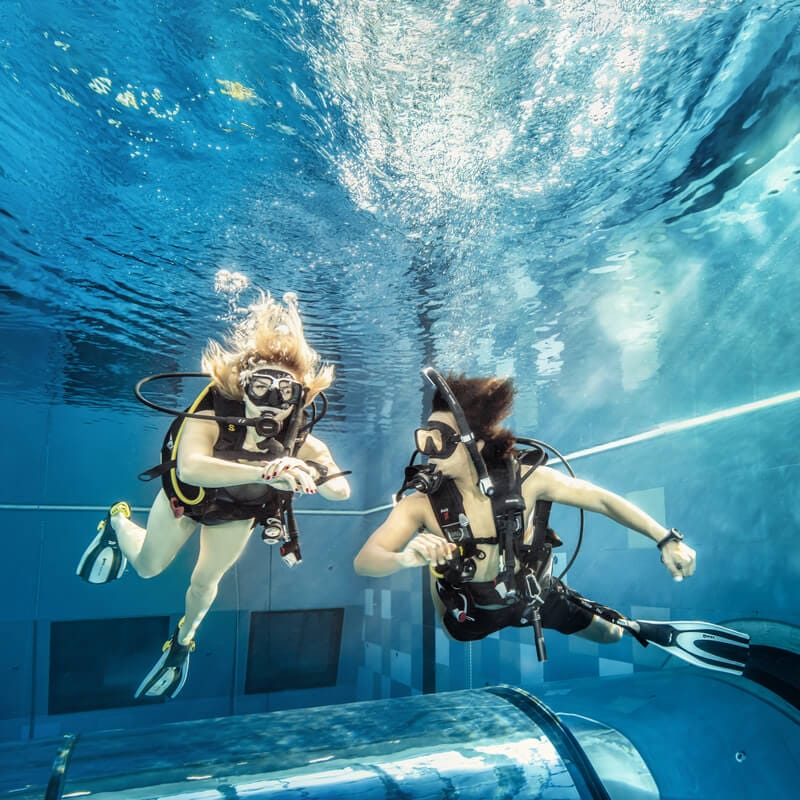
The first dive class by the chosen method lasts 90 minutes (Scuba Diving) or 120 minutes (Freediving) and takes place in the safe, maximum comfortable conditions of a diving simulator. The water has an optimal and constant temperature of 32-34 degrees Celsius at all depths. Each class participant receives a certificate of diving in Deepspot. If after the first dive we feel like doing more – it’s time to enroll in a course developed by one of the training organizations / diving schools. Earning more certificates and diving degrees is the only way to develop your skills and expand your credentials. In addition, you can also develop a specific specialty, such as night diving, underwater photography or wreck diving.
Who can dive?
What are the prerequisites for a diving adventure?
- Appropriate age – according to the standards of diving organizations, scuba diving is intended for healthy adults (with no upper age limit), adolescents and children from 8 years of age (conditionally: in the case of the youngest children, low weight and attention problems may be a contraindication);
- good health – recreational diving is available to all healthy people with no health contraindications (contraindications are described below); consult a doctor before embarking on a diving adventure;
- Physical fitness – should be at least at an intermediate level, as recreational diving is slightly more demanding than recreational swimming, primarily due to more difficult underwater conditions and the need to use additional, relatively heavy equipment (scuba diving) or master the technique of effective and safe breath-holding (freediving).
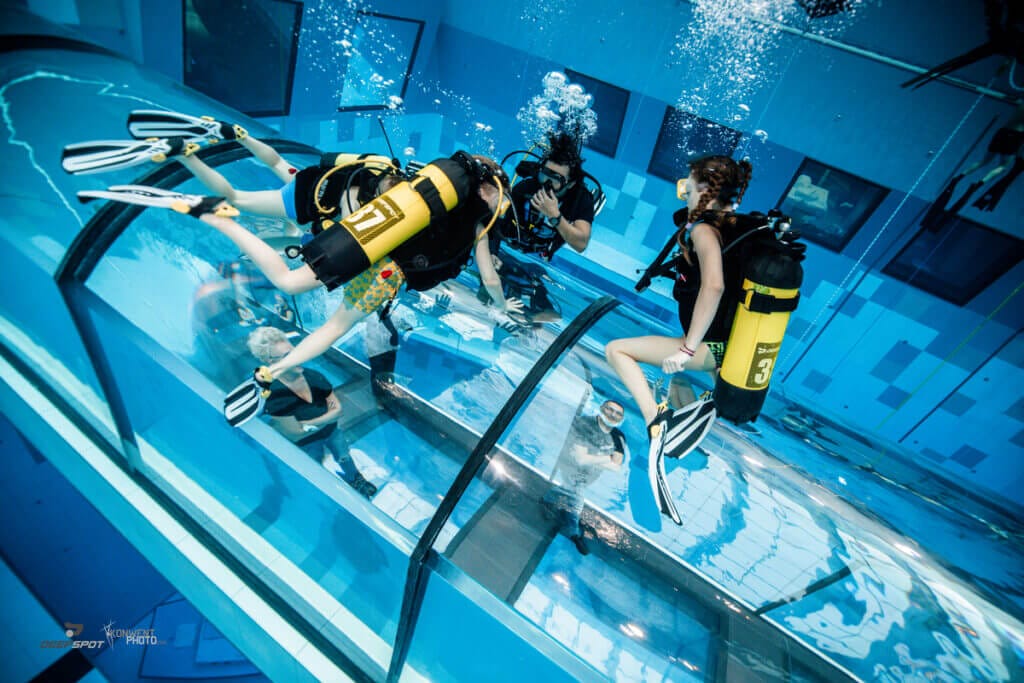
Swimming skills – do you need to know how to swim to dive?
Diving is an activity for people who feel comfortable in the water, and in the vast majority of cases – the ability to swim is the basis of comfort and a guarantee of safety. It is theoretically possible for non-swimmers to practice scuba diving, while amateur snorkeling cannot be done without this skill. In practice, however, any person who thinks about developing a new passion after the first trial dive – should have the ability to swim at a minimum intermediate level.
Most diving federations that certify diving courses and degrees, require a person wishing to enter training – the ability to swim: 200 meters on the water surface (any style, in any time) and to swim 15 meters underwater. The better we know how to swim, the more confident and safer we feel in the water, and thus we can enjoy diving more. In parallel with developing your diving skills, it is therefore worthwhile to train swimming, including ABC swimming (mask, snorkel, fins).
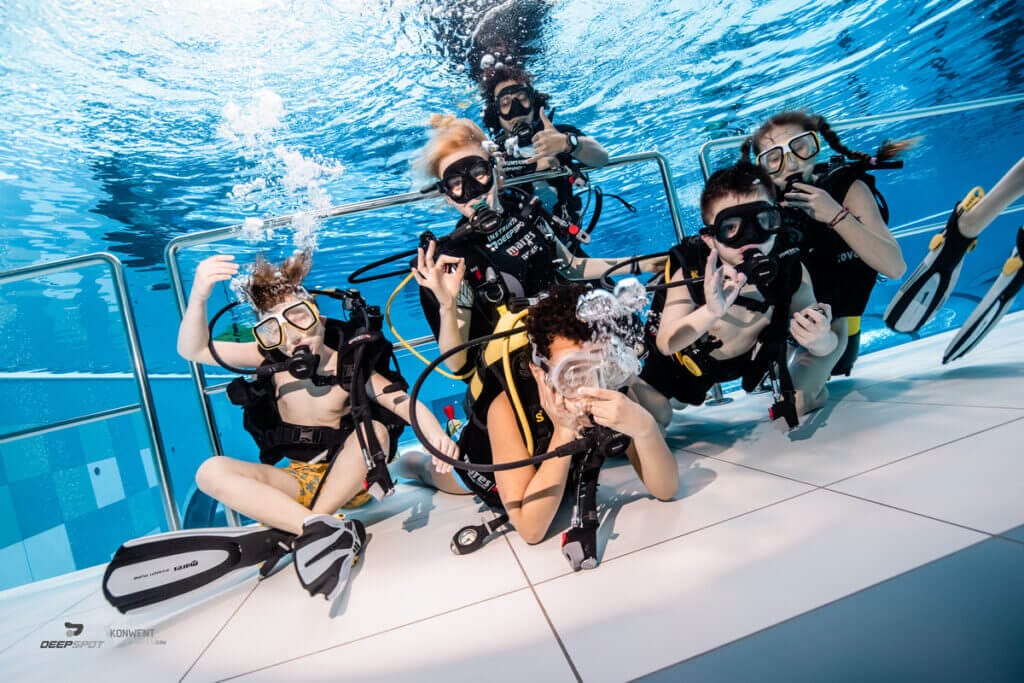
Contraindications to diving
Recreational diving, performed under the supervision of experienced instructors and in compliance with all safety rules, can be practiced by healthy adults, adolescents and children from 8 years of age, provided that the existence of contraindications to diving has been excluded.
Absolute or relative contraindication (requiring medical consultation, in-depth case analysis or postponement of the start of diving – until the contraindication is eliminated) to start and/or continue the diving adventure is:
- Lack of swimming skills and fear of water
- general malaise (on the day of the scheduled dive)
- Being under the influence of alcohol, intoxicants, psychoactive drugs (on the day of the scheduled dive)
- Active viral or bacterial infection (including but not limited to: cold, flu, ear infections, sinus infections, inflammation/infections in the respiratory tract)
- Serious respiratory diseases, including but not limited to: asthma, emphysema, tuberculosis, COPD (chronic obstructive pulmonary disease)
- diseases or operations of the ear
- Infections or other chronic sinus problems
- heart or circulatory system diseases
- surgeries performed during the 12. Months before diving, primarily surgeries: heart, lung, and spine (other surgeries and surgeries previously undergone should be consulted with your doctor)
- diabetes
- high cholesterol
- hypertension
- back diseases
- hernia / hernias
- pregnancy
- bleeding or blood clotting problems
- Identification of a personal or family history of medical conditions including: heart attacks, strokes, strokes or other heart disease (especially involving people of young age)
- Nervous system disorders, cases of unconsciousness or syncope
- Behavioral disorders, claustrophobia, agoraphobia, epilepsy, anxiety, panic attacks.

Is diving safe?
The key to safe scuba diving, like the safe practice of any other sport, is to follow the rules. Recreational diving can therefore be safe, provided that it is practiced in accordance with all safety guidelines and rules, under the supervision of a qualified instructor, using high-quality, properly serviced equipment and having established the absence of any contraindications in the diver.
This desire to minimize risks and prevent emergencies should accompany every diver, regardless of the type/purpose of diving, level of proficiency, dive grade, and experience and number of dives performed. Reduced vigilance and negligence can lead to serious trouble, posing immediate threats to health and life.
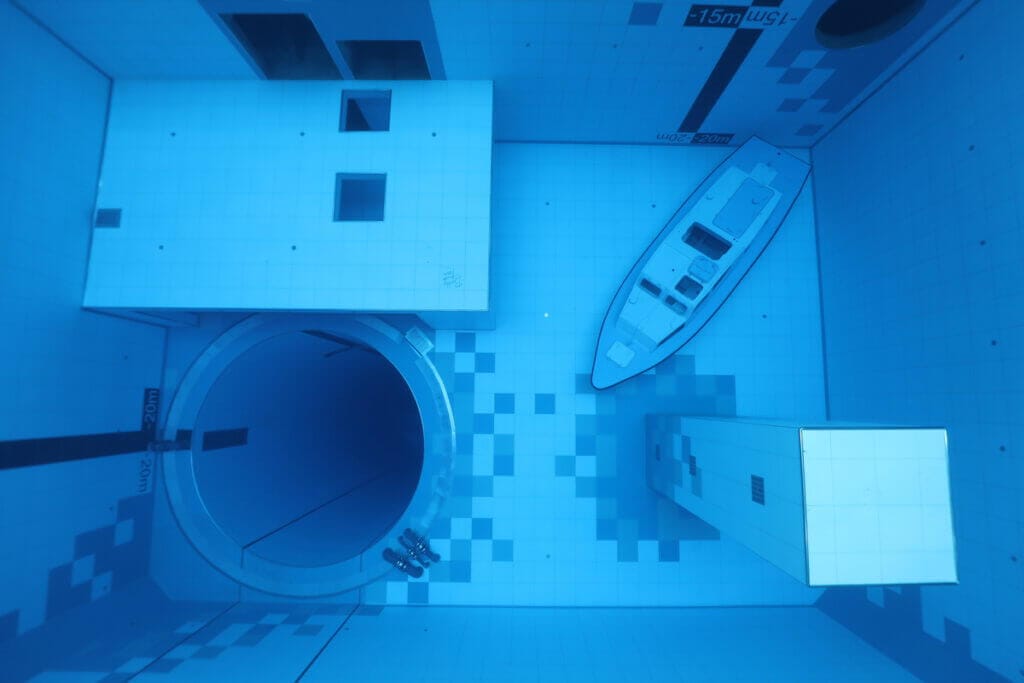
Basic diving hazards (emergency situations)
When diving, as with any other sport, there can be risks. In the context of diving, we talk about emergency situations (all situations that changed the established diving plan due to safety priority, but did not require the call and pre-medical assistance, were controlled and did not lead to a threat to health or life) and diving accidents (emergency situations that required the call and pre-medical assistance, led to a threat to life and / or damage to health).
Basic and most frequently recorded emergencies:
- lack of air (with a lot of CO2, not enough oxygen) – this is one of the most dangerous situations we can face underwater during scuba diving (equipment diving); minimize the risk: in preparation for diving, you should learn how to use an aqualung (including in emergency situations) and train breathing and breath-holding (in order to maximize the amount of time you can last without breathing – it may be necessary, for example, for a safe ascent);
- body hypothermia – failure to adjust the diver’s clothing to the diving conditions (water temperature, depth and dive length) is one of the most common mistakes, especially by novice divers;
Minimize the risk: take care of a properly selected outfit that provides solid thermal insulation – a thick neoprene foam or dry suit (maximum protection against hypothermia); - Diver fatigue – failure to adjust the pace of the underwater swimming speed to one’s own skills and fitness can cause fatigue that makes it difficult or impossible to continue diving;
Minimize the risk: adjust the pace of swimming to one’s own skills and fitness, a tired diver should rest, holding on to a partner, a rock, the bottom (in the case of shallow tanks / bodies of water) or a lowering rope, if after a moment of rest the diver is unable to continue diving – start the ascent procedure; - Leg cramp – a painful muscle cramp can make it difficult or impossible to continue the dive, the painful muscle should be stretched and massaged (if possible, preferably with the help of a partner); while continuing the dive, limit forcing the muscle, and if the cramp(s) recur – start the ascent procedure and end the dive;
- losing a partner or group – the risk of losing a partner or group exists primarily during diving, among other things. in Polish waters, where in summer, visibility can be limited to a few tens of centimeters already at a depth of several meters;
Minimize risks and rules: maintain constant eye contact during the dive, in the situation of getting lost – make an attempt to find it (specified in time, such as 1-2 minutes), then begin to pry; - Bites, bites, cuts – when diving in natural bodies of water, we have the opportunity to admire the underwater world of flora and fauna, as well as various types of submerged objects that are man-made, stroking and grasping animals, touching plants and exploring objects can cause injuries;
Minimizing risks: during recreational diving, it is best to limit yourself to eyewitness, non-contact admiration of the underwater world; - entanglement in trash lying under water – Old fishing nets, fishing lines and other types of trash lying underwater are a potential risk of entanglement by the diver and problems with continuing the dive or ascending; in an entanglement situation, the first thing to do is to check how much air you have (as long as you have something to breathe – you are safe), calm down, and then develop a plan to free yourself;
Risk minimization: the diving instructor and experienced divers diving in natural bodies of water should be equipped with the so-called “diving equipment”. Diver’s safety knife to remove the hazard.
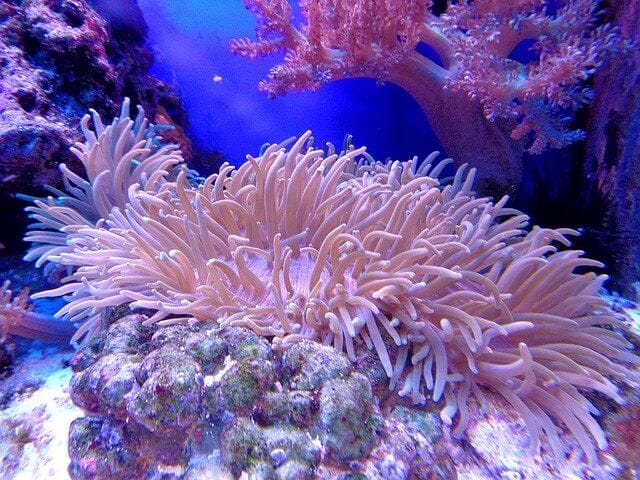
Threats to divers at higher levels are: decompression sickness and nitrogen narcosis (these threats do not apply to beginner divers, provided that they strictly follow safety rules and do not exceed the depth limits allowed for them).
Partner diving
The basis of safe recreational diving is partner diving, or diving with a partner. Note: the partner cannot be any person who will simply accompany us underwater! The dive partner should be qualified and ranked (according to the guidelines for diving ranks and general rules for safe diving) and experienced.
The partner system involves diving in teams of two people, who before the dive: jointly develop a dive plan and check each other’s equipment and buoyancy.
During the dive, the diving couple:
- swims close to each other – in an agreed manner: side by side, one with the other, freely, but remaining in eye contact (usually at arm’s length or two, depending on visibility underwater),
- helps himself during the dive – among other things. by checking the partner’s cylinder pressure and signaling the levels: 100at and 50at (a drop in cylinder pressure to reserve should indicate the start of the ascent procedure, so that you can finish the dive with the air pressure in the cylinder before it drops to a value of 20 – 30 at).
- helps himself in emergency situations –
- helps himself to diving accidents –
An essential element of effective and safe diving in a partner system is effective communication – before diving, you should remember the basic diving signs (signs shown with hands, but also signs using touch, sound or light).

For those starting out and trying diving for the first time – the dive partner is an instructor / coach.
Dive signs – communication in diving
Diving requires the use of non-verbal modes of communication, which have been developed and described as universal diving signs. Diving signs are demonstrated with hands.
The most commonly used diving signs fall into one of four categories:
- General signs – basic, general diving signs: ok, me, you, I don’t understand, collection, number signs;
- Directional signs – signs that allow you to indicate / determine the direction of swimming:up, down, indicating the direction of swimming horizontally, level (indicating stopping or swimming at this depth);
- signs of speed of movement – signs that allow you to determine the speed / change the speed of swimming: slower, faster, stop;
- other diving signs / danger signs – signs that allow you to quickly and effectively signal emergency situations: something not right, no air, equalize the pressure, dizziness, reserve, open my reserve.
Dive signs should be shown accurately and slowly, outside the outline of the body – the dark background of our diving suit can make it difficult or impossible for our partner to correctly read and interpret the signs.
Effective communication using diving signs requires focusing your partner’s attention. Underwater, in a situation where we want to make eye contact with our partner and draw his attention to ourselves in a way that will simultaneously pre-signalize the seriousness of the situation, we can: swim up to the partner and shake his leg or hand (one hug – we are calm, many hugs – we are nervous), draw attention with a sound / acoustic signal (by hitting the cylinder once or repeatedly, with a diving knife or a special bead), or draw attention with a light signal (by waving the flashlight vigorously once or repeatedly in the up-down option, giving the effect of a strobe light).
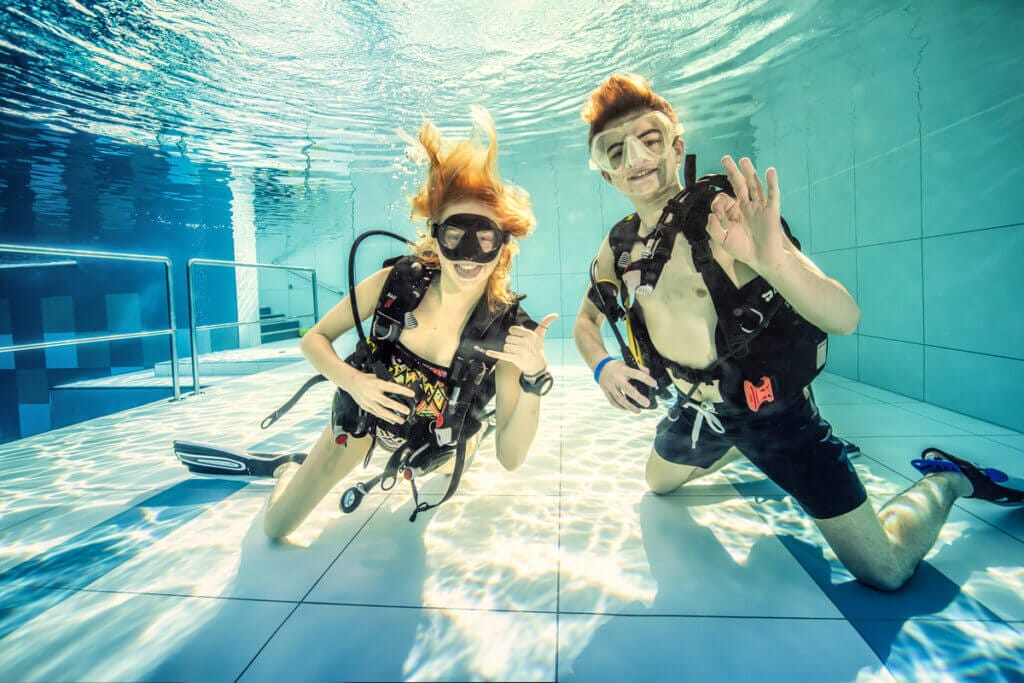
Diving degrees – courses and training for divers
Diving degrees are earned after completing successive courses / stages of training. Courses should be conducted by professional schools or organizations affiliated with international diving organizations (see below for a list), operating under standards set by these organizations. The degrees and courses themselves may have different names, depending on the international organization that certifies the training in question.
Diving degrees – for children and young people, recreational and professional
Scuba Schools Internasional (SSI) basic diving degrees:
- SSI Open Water Diver (SSI OWD, level 1) – the first level/degree of diver; in the course, the diver acquires the basic knowledge and fundamental skills necessary to dive safely to a depth of 18 meters with a partner of equivalent skills and to 30 meters under the supervision of a qualified instructor; minimum age of the diver: 15 years.
- SSI Advanced Adventurer (SSI AA, level 2) – the second level / degree of diver; the course deepens knowledge and acquires specialized skills (three mandatory: Deep Diving, Night & Limit Visibility Diving, Navigation Diving plus one: to be chosen by the diver); the condition for obtaining a license is a minimum of 24 dives in open water; AOWD license entitles the diver to dive to a depth of 39 meters with a partner of equivalent or higher qualification and to dive with a partner of lower qualification (within the scope of the partner’s qualification/qualification); minimum age of the diver: 15 years.
The SSI OWD and SSI AA degrees have their equivalent counterparts in other diving federations/organizations, such as. PADI (PADI OWD and PADI AOWD), CMSA (P1 and Explorer) or SDI (SDI OWD and SDI AOWD).
After completing the advanced course and earning the appropriate license (AOWD) – a diver can progress further by earning professional diving degrees. The SSI Federation offers the opportunity to earn the degrees in sequence: Dive Guide, Divemaster, Assistant Instructor, Open Water Instructor, Advanced Open Water Instructor, Divemaster Instructor, Assistant Instructor Trainer and Instructor Trainer.
Children and teenagers up to the age of 15, can take part in SSI certified courses dedicated to them, including. SSI Snorkel Diver and SSI Scuba Diver. The Junior Open Water Diver (JOWD) course is dedicated to young people aged 10 and older. A JOWD license entitles you to dive to depths of up to 12 meters in tandem with an adult chaperone who holds a diving license. When a diver reaches the age of 15 – he can exchange his JOWD license for an OWD license (without additional courses and exams).
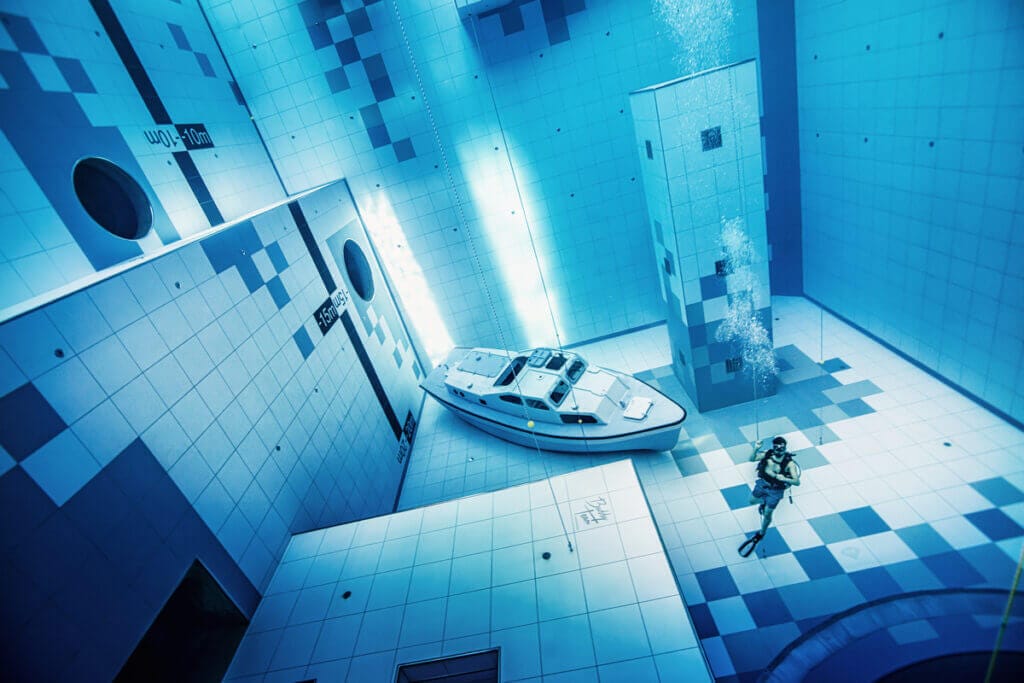
Diving specialties
Specialized diving courses are training courses in which a diver focuses on improving or developing specific skills or gaining new qualifications. Various diving specializations and specialized courses can be dedicated to divers who have a specific diving degree – some of them are available after the basic OWD course, others will require completion of the advanced AOWD course beforehand.
Examples of SSI diving specialties (so-called Specialty Diver), after the basic course (SSI OWD):
- deep diving (Deep Diving)
- Night & Limit Visibility Diving (Night & Limit Visibility Diving)
- navigation (Navigation Diving)
- equipment knowledge (Equipment Techniques)
- exploration and recovery (Search and Recovery)
- wreck diving (Wreck Diving)
- diving from a boat (Boat Diving)
- computer diving (Computer Diving)
- dry suit diving (Dry Suit Diving)
- ice diving (Ice Diving)
- diving with nitrox (Enriched Air Nitrox)
Examples of PADI diving specializations after the basic course (PADI OWD):
- PADI Dry Suit Diver – dry suit diving course
- PADI Equipment Specialist course.
- PADI Underwater Navigator – underwater navigation course
- PADI Night Diver – night diving course.
- PADI Boat Diver – diving course from a boat.
- PADI Peak Performance Buoyancy – Excellent Buoyancy diving course.
- PADI Drift Diver – current diving course
- PADI Multilevel Diver course.
- PADI Propulsion Vehicle Diver – underwater scooter diving course
- PADI Search and Recovery Diver – diving course: search and recovery
- PADI Foto Specialist underwater photography course.

Diving organizations and diving schools
There are a great number of organizations and diving schools in the world that provide certified courses and training. Most organizations and schools mutually recognize certifications obtained by divers in other organizations/schools.
The most well-known and largest diving organizations in the world, bringing together smaller organizations and schools to provide training and set standards for courses and requirements for each diving degree:
- PADI(Professional Association of Diving Instructors) – the world’s largest organization training divers at all recreational and professional levels; the diving standards set by PADI are adopted (in whole or in majority) by the other major organizations in the world;
- CMAS(Confederation Mondiale desActivites Subaquatiques) – a federation of diving organizations from around the world, in Poland the CMAS affiliated organization is, among others. Polish Scuba Diving Association;
- SSI(Scuba Schools International) – an international organization that trains divers and diving instructors around the world, SSI training is characterized by very high quality, and diving certificates issued by SSI are recognized worldwide, at all levels, recreational and technical and instructor;
- TDI(Technical Diving International) – the world’s largest technical diver training organization;
- SDI(Scuba Diving International) – a sister organization to TDI, training recreational divers;
- IANTD (International Association of Nitrox and Technical Divers, formerly: IAND – International Association of Nitrox Divers) ) – the first organization to introduce Nitrox, and later Trimix, to sport diving.
Deepspot is not only Europe’s deepest multi-zone diving simulator, but also a venue for full-fledged professional training courses. The international team of trainers and instructors has extensive knowledge and experience to train adept divers safely and with maximum efficiency. At Deepspot, you can both try diving for the first time in your life and gain specific skills and qualifications – appropriate to your diving degree (according to SSI standards).
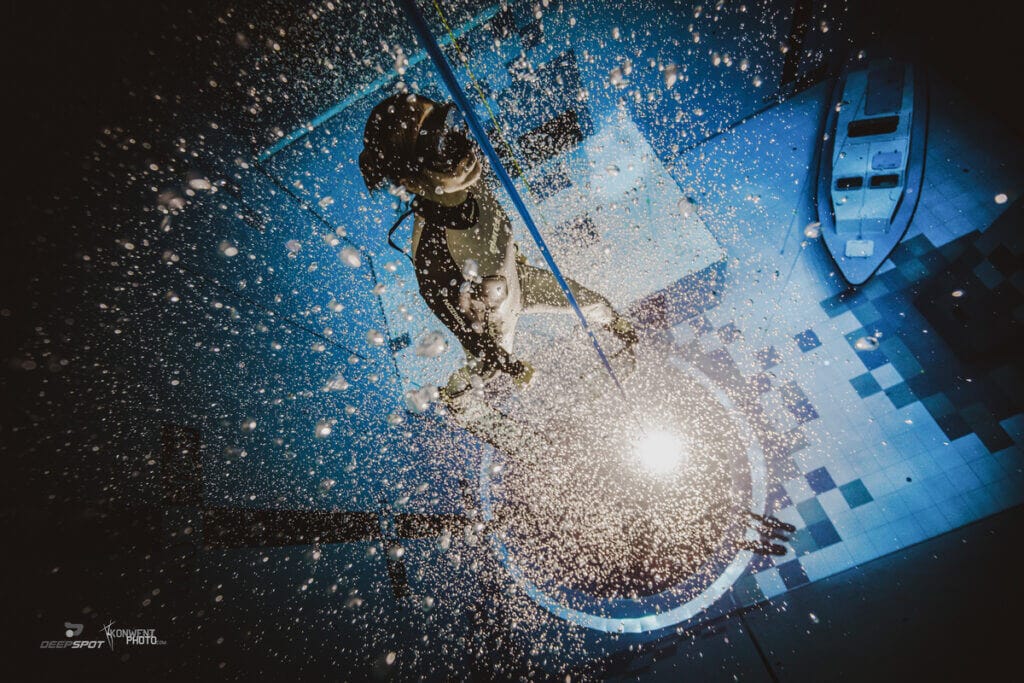
The most interesting diving sites in Poland and around the world
When looking for interesting natural bodies of water for diving and exploring underwater flora and fauna, check out a selection of quarries and lakes in Poland:
- Quarry near Piechcin – an attractive diving and training base, easy to navigate, with many sunken platforms and diving attractions that are very well marked on the surface
- Zakrzówek Lagoon (flooded limestone quarry) in Cracow – at the bottom of the quarry, at a depth of 7 to 20 meters, there are, among others: a large fiat, a van and various elements of the former workers’ town;
- Lake Piłakno (Mragowo Lake District) – large area and very good conditions for diving
- Lake Hancza (East Suwalskie Lake District) – a post-glacial lake with clear water and excellent diving conditions, especially for experienced technical divers
- Kłodno Lake (Kashubian Lake District) – a channel lake, with the Radunia River flowing through it (the current water level in the lake depends on it), a lake located in the picturesque Kashubian Landscape Park
- Lake Pile (Drawskie Lake District) – in the middle of the lake there is an island, fragments of which, along with the forest growing on it, have been submerged, some trees are still under water, creating a phenomenon called “submerged forest”.
- Lake Pluszne (Olsztyn Lake District) – a moraine lake with a reed islet, which during World War II served as a target for concrete bombs dropped by German planes, the satisfactory state of the water allows you to admire not only the bombs, but also the relatively lush flora and fauna.
Diving in the world? Hugely popular among Polish diving enthusiasts is the Red Sea and Egypt, as well as the coasts of Cyprus, Malta and Croatia. Deciding to spend a little more and travel further, you can with diving equipment visit, among others: Maldives, Borneo, Cayman Islands and Mexico (especially the remarkable Banco Chinchorro).









